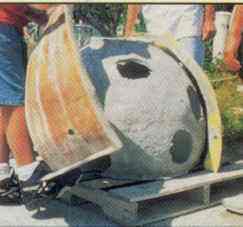
(August 1995)

(August 1995)
Reef Balls
In a shining example of good of American ingenuity, inventor Jerry
Barber and his son Todd have come up with still another low-cost, environmentally safe
answer to building and deploying artificial reefs. They call their brain-child Reef Balls.
Although the concept has undergone years of development and several generations of
refinement, Reef Balls are essentially a realization of Jerry's original idea to just
"buy some big beach balls, coat them with concrete and roll them down the
beach." Of course, the end product was a little more sophisticated than that.
Traditionally, placing specially manufactured artificial reefs is a
very expensive and labor-intensive endeavor. Reef Balls, on the other hand, require
nothing more than a few divers and a small boat. Because they are molded around a reusable
inflatable bag - like Jerry's beach ball idea - the modules are buoyant. So, even modules
weighing over a ton can be easily towed to the desired area. Then, after deflating the
bag, they're gently dropped into place in the desired location. The number of modules used
dictates the eventual size of the reef. Currently, Reef Ball artificial reefs, ranging
from only a few modules to thousands, are attracting marine life in locations as diverse
as the Caribbean, Florida, South Carolina, Georgia, Maryland, New York and British
Columbia. Internationally, Reef Balls have been deployed in England and Mexico, and most
recently, massive projects involving over 45,000 modules are under consideration in
Jamaica and Kuwait.


Three weeks after sinking,dense algae, hydroids and several small fishes
surround a reef ball sunk off Florida's Gold coast. PHOTO CREDIT:
PHIL DAVIS
Working in concert with a number of reef scientists, environmental
engineers and concrete companies, Reef Balls are not only environmentally safe, but
manufactured for very precise resource management goals. By altering the concrete mixture,
surface texture and hole size, modules can attract different types of organisms, For
example, in South Carolina and Georgia, granite was added to the concrete to promote soft
coral development. In Florida, where the growth of hard corals was the objective,
limestone was added to the mixture. The size of the holes helps determine the size of the
fish attracted, and the rough surface texture ensures an ample fouling assemblage and a
healthy community of invertebrates. As they're environmentally inert, marine life call
move onto the structures immediately upon placement (something that's not possible with
traditional concrete structures ). Some studies have even shown reefs constructed of Reef
Balls to produce up to three or four times the species diversity and double the amount of
biomass (a measure of all living organisms) than on other types of artificial reefs.
Reef Balls are already attracting a lot more than fish; they have been
featured on CNN, and in USA Today and Popular Science. So don't be
surprised to see the Barbers' invention sometime on an existing - or future - dive site.
For more information, you can contact Todd Barber, Reef Ball Development Group, Ltd., 7085
Chappell Circle, Doraville, GA 30360; phone -404-840-8389; fax 404-242-9033.